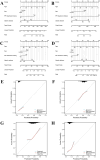Analysis of Helicobacter pylori resistance in patients with different gastric diseases
- PMID: 38418852
- PMCID: PMC10901771
- DOI: 10.1038/s41598-024-55589-2
Analysis of Helicobacter pylori resistance in patients with different gastric diseases
Abstract
Helicobacter pylori (H. pylori) resistance is the most important risk factor for eradication failure. However, in most regions, antibiotic resistance rates of H. pylori in patients with different types of gastric mucosal lesions are still unclear. An 8-year clinical retrospective cohort study involving 2847 patients was performed. In this study, we first summarized and compared the resistance status of H. pylori in different years, ages, sexes, and gastric diseases. The resistance profiles of amoxicillin (AMX), clarithromycin (CLR), levofloxacin (LVX) and furazolidone (FR) and their changing trends in the clinic were described. Then, multiple antibiotic resistance in different gastric diseases and years were described and compared. The relationship between proton pump inhibitor (PPI) medication history and antibiotic resistance in H. pylori was also explored. Finally, an antibiotic resistance risk model was constructed for clinical resistance risk prediction. The overall resistance rates of AMX, CLR, LVX and FR in gastric diseases were 8.18%, 38.11%, 43.98%, and 13.73%, respectively. The mono resistance, double resistance, triple resistance, and quadruple resistance rates were 30.17%, 25.96%, 6.46%, and 0.63%, respectively. Compared with the period from 2014 to 2016, the rates of mono-resistance and multiple resistance all showed relatively downward trends in the past 5 years. Factors including age, sex, type of gastric lesions and recent PPI treatment history are associated with the antibiotic resistance rate of H. pylori. Atrophic gastritis is an important clinical feature of high-risk antibiotic resistance in H. pylori-infected patients. Patients with atrophic gastritis have higher risk of resistant strains infection. In this study, our data provide the association between antibiotic resistance of H. pylori and gastritis pattern, which indicate the higher risk of resistant strain infection if the patients with atrophic gastritis, PPI history and older age.
Keywords: Helicobacter pylori; Antibiotic resistance; Antimicrobial susceptibility test; Atrophic gastritis; Proton pump inhibitor.
© 2024. The Author(s).
Conflict of interest statement
The authors declare no competing interests.
Figures

Similar articles
-
Antibiotic resistance of Helicobacter pylori and related risk factors in Hunan Province: A multicenter study.World J Gastroenterol. 2025 Mar 28;31(12):104835. doi: 10.3748/wjg.v31.i12.104835. World J Gastroenterol. 2025. PMID: 40182588 Free PMC article.
-
High rates of clarithromycin and levofloxacin resistance of Helicobacter pylori in patients with chronic gastritis in the south east area of Vietnam.J Glob Antimicrob Resist. 2020 Sep;22:620-624. doi: 10.1016/j.jgar.2020.06.007. Epub 2020 Jun 24. J Glob Antimicrob Resist. 2020. PMID: 32590188
-
Characteristics of phenotypic antibiotic resistance of Helicobacter pylori and its correlation with genotypic antibiotic resistance: A retrospective study in Ningxia.Helicobacter. 2023 Jun;28(3):e12960. doi: 10.1111/hel.12960. Epub 2023 Apr 11. Helicobacter. 2023. PMID: 37042045
-
Novel and Effective Therapeutic Regimens for Helicobacter pylori in an Era of Increasing Antibiotic Resistance.Front Cell Infect Microbiol. 2017 May 5;7:168. doi: 10.3389/fcimb.2017.00168. eCollection 2017. Front Cell Infect Microbiol. 2017. PMID: 28529929 Free PMC article. Review.
-
Helicobacter pylori eradication therapy.Future Microbiol. 2010 Apr;5(4):639-48. doi: 10.2217/fmb.10.25. Future Microbiol. 2010. PMID: 20353303 Review.
Cited by
-
Prevalence of Helicobacter pylori infection in patients with upper gastrointestinal disorders using different methods in Khuzestan, Southwest Iran.Mol Biol Rep. 2025 Aug 11;52(1):813. doi: 10.1007/s11033-025-10905-5. Mol Biol Rep. 2025. PMID: 40788504
-
Optimized therapeutic potential of Sijunzi-similar formulae for chronic atrophic gastritis via Bayesian network meta-analysis.EXCLI J. 2024 Sep 6;23:1185-1207. doi: 10.17179/excli2024-7618. eCollection 2024. EXCLI J. 2024. PMID: 39421026 Free PMC article.
-
Antibiotic resistance of Helicobacter pylori and related risk factors in Hunan Province: A multicenter study.World J Gastroenterol. 2025 Mar 28;31(12):104835. doi: 10.3748/wjg.v31.i12.104835. World J Gastroenterol. 2025. PMID: 40182588 Free PMC article.
-
Hidden in Plain Sight: Delayed Diagnosis of Poorly Cohesive Gastric Carcinoma in a Young Male Patient.Cureus. 2025 Jul 1;17(7):e87097. doi: 10.7759/cureus.87097. eCollection 2025 Jul. Cureus. 2025. PMID: 40606407 Free PMC article.
-
Network analysis of H. pylori effect on AGS human gastric adenocarcinoma cells gene expression profile.Gastroenterol Hepatol Bed Bench. 2024;17(4):415-421. doi: 10.22037/ghfbb.v17i4.3023. Gastroenterol Hepatol Bed Bench. 2024. PMID: 40406433 Free PMC article.
References
MeSH terms
Substances
Grants and funding
LinkOut - more resources
Full Text Sources
Medical
Miscellaneous

